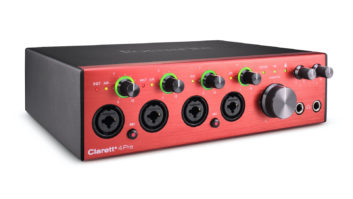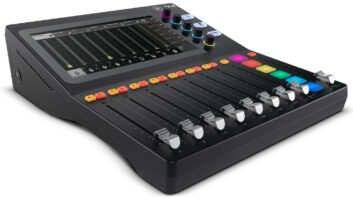The Mackie ProFX22 — a 4-bus analog live mixer with lots of features — is one of those products that musicians congratulate you on after the gig … and especially after they hear what it costs ($650 street). During my time with it, the most descriptive quote I’ve heard from a band member surely must be “man — that is all you need!”
Anyone from aspiring self-mixing bands to smart, old school live sound dudes would be happy with this mixer, as it eliminates carrying around a lot of things you’d rather not: outboard comps and reverb hardware, for starters. Then add in its USB capabilities: DAW returns on channels 21/22 and subgroup 1/2 or main L/R recording features: good, straightforward stereo DAW I/O in a totally for-live, amazingly compact mixer. Its four channel “one knob” compressors work well and simply, and its simple array of 16 digital effects (reverbs, choruses and delays) are most likely enough for your gigging needs.
Main Features
The ProFX Series’ flagship model, the 22-channel ProFX22 prominently features 16 clean microphone preamps with insert points on the first 10 channels; inline channel compression for four inputs (channels 11-14); Mackie’s RMFX 32-bit mono in/stereo out digital effects processor; a seven-band graphic EQ with well-chosen frequency points (125, 250, 500, 1k, 2k, 4k and 8k Hz, +/-15dB), switchable between Main Mix and Monitor 1 outputs; stereo/dual mono USB I/O (subgroups 1/2 or main L/R via USB to your DAW of choice); and lovely-sounding three-band EQ with sweepable midrange (mono channels).
Approximately 25” long by 16” deep, the ProFX22 is compact and lightweight enough (18 lbs.) to very easily carry under your arm, yet large enough to easily and comfortably mix mains and monitors with just enough crowd- and band-pleasing effects and channel compression, ultimately satisfying the requirements for small- to medium-sized venue gigs in a most professional manner.
In Use
Over the span of six months, I employed the ProFX22 anywhere I could use an analog mixer with plentiful I/O and high quality digital effects. Most often, it served as an impeccable-sounding club mixer, but it also worked well as a mixing console for studio recording/tracking; it was my monitoring desk for multitrack playback as well as a great digital effects source for one particular “guerilla-style,” iTunes/Amazon-only single release I recently produced. I’m convinced that the RMFX processor sounds far better than anyone would be inclined to suspect, especially considering the ProFX22’s price point.
As most street-level musicians and self-recordists well know, owning gear that onlyyouknow how to use is a potential recipe for disaster. In predictable Mackie fashion, the ProFX22 is so intuitive that most musicians with knowledge of simple signal flow can feel very comfortable using it with very little preparation or worry (please see the ProFX12 sidebar for more on this subject). In instances where you may be both the live sound “contractor” and a performer, the ProFX22 always allows for a quick setup and sound check, then after a quick tutorial you can hand over the reigns to someone else, sans ulcer-causing worries. I enacted this exact scenario a couple of times while using the ProFX22; at the end of each gig, the stand-in mixers both commented how comfortable they were with level, EQ and effects adjustments. By the end of the gig, they were confidently tweaking parameters that they wouldn’t have dreamed of touching at the start of the gig. As such, this ProFX mixer seems to encourage user confidence like no other analog mixer I’ve experienced.
Summary
Reviewing the ProFX22 has been a pleasure, as it just makes gigging life simpler. It instills confidence, both in its user-friendliness as well as its Mackie-ness — it always works, always sounds good, and is affordable but never “cheap.”
So, is the ProFX22 truly all you need? Toss the appropriate cables and microphones in the bag, grab your laptop for event recording and playback, and pack those powered speakers, too: it may just be.
Price: $809.99 list
Contact: Mackie | mackie.com/products/profx22
ProFX12: A “Wow” for Small HOWs
Also reviewed in this time period, Mackie’s smallest ProFX mixer — the ProFX12 (approximately $280 street) — ideally met the needs of my local house of worship, Brown Mountain Church. BMC’s pastor detailed their need for a portable PA system in contemporary worship music applications, both in the church, outdoors, and for performances at nearby churches and other venues. Feature-wise, the nearly-square (14.05” x 14.6”) ProFX12 lacks the “one knob” channel compressors of the ProFX22, while other features are simply less in number: most notably, six XLR inputs, a simplified three-band EQ, and one less aux send per channel.
Paired with dual Mackie HD1221 main monitors and a pair of Mackie TH-12A stage monitors, the ProFX allowed BMC to quickly set up and dial in a surprisingly complex, full-bodied mix, with the aforementioned, carefully chosen 16 digital effects always sounding lush and deep, rather than chintzy (as low-cost digital effects sometimes can).
Arguably, user-friendliness is never more important than in a house-of-worship setting. Here, the ProFX12 carries the same intuitive traits as the flagship ProFX22 mixer, not to mention Mackie’s entire analog mixer line. If you get to know one Mackie mixer, you pretty well know them all. In approximately 15 minutes, I gave the pastor a manual-less tutorial on the ProFX12’s signal flow, and a week later, he drove the rig — without any assistance from me — to resounding accolades of his congregation. I believe he was both impressed and relieved that the ProFX12 was so good and so easy to use.
Finally, having the ability to record performances via USB to a DAW of choice future-proofs the ProFX12 for HOWs such as Brown Mountain Church, a fact that the pastor fully recognized and appreciated from a ministry and growth perspective.
For all these reasons, I’d recommend the ProFX to any small- to medium-sized house of worship needing additional, and/or mobile, contemporary music sound reinforcement. — Strother Bullins







